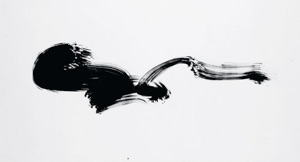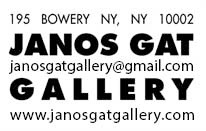A handful of paintings in New York museums is scant guarantee that the name Judit Reigl will ring a bell here in the United States; her status is likely different in France, where her long career began in 1950 following a harrowing escape from her native Hungary in the wake of its absorption into the Soviet Bloc.
Having reached France, Reigl was drawn to the ossified circle of André Breton, briefly taking on and as quickly throwing off an illustrative mode recalling that of Victor Brauner and Max Walter Svanberg (rather dim Surrealist luminaries for whom Breton was then tub-thumping), but remaining faithful to the automatisms that mark Breton’s important theoretical contributions to Surrealism. Of these, l’écriture automatique would come to play a preponderant role in both her painting and her drawing.
The present exhibition at Ubu Gallery contains only Reigl’s automatic works, many of them scrolls she placed upon the floor and deftly worked with ink-saturated sponges. Whether from the 1950s, ’60s, or last year, these were all made the same way: Undiluted china ink applied with a natural sponge to paper, which was always laid out at the full length of the studio, pulled from a large roll.
Another type of Reigl’s automatic-writing-as-drawing, represented by the series “Ècriture d’après musique” (Writing After Music), 1965–66, comprises tiny variant scripts generated by the effect of the sound upon the artist’s hand. One such drawing bears the inscription varese; another, NEGRO SPIRITUAL, though specific sources are rarely indicated. This scriptlike aspect of her work recalls that of Brion Gysin and Henri Michaux, linking Reigl to the French adoption of a mode particularly associated with the Beats, who, at the turn of the 1960s, enjoyed considerable vogue in Paris.
Later, Reigl’s gift for an elegant coloristic abstraction flourished, at times insinuating a written-upon page. Two series of generally bicolored fields, “Unfolding,” 1973–80, and “Unfolding Continued,” 1980–85, suggest a structure of lines upon which telegraphic abstract shapes become, in a certain sense, sequences of small, illegible words. Four such large, refined abstractions are included here. (To be sure, there are also moments of resurgent figuration in the Reigl corpus, dark paintings of the male nude in the manner of Matisse at his most silhouetting—think La Musique [Music], 1910—though work of this type does not appear in the Ubu show.)
But of whatever type her art may be, here, Reigl’s drawings are given pride of place. Deeply marked by Asian calligraphy, they embody a desire to keep the gesture as fresh and free of an admonishing superego. Hence, she executes them very rapidly—automatically but astutely—as jets of pure id, but utterly aesthetic for all that. In this regard, Reigl falls squarely within the purview of the so-called Tachiste painting typical of French postwar abstraction. This is both high accomplishment—think Gérard Schneider, Jean Degottex, and Georges Mathieu (who, among the Tachistes, made the greatest impression upon her)—and a hindrance; in the United States, a near-chauvinist preference for New York–grown, supposedly more raw gestural abstraction has rendered the parallel French strain shibboleth.
The Frenchness of Reigl’s abstraction (not to mention the inherent sexism of the postwar art world of whatever nation) conspired to keep Reigl a secret (at least in this country), one that this exhibition is helping to dispel. A fascinating catalogue essay—though it is perhaps a tad mythologizing—by Janos Gat, a scholar and Reigl’s New York dealer, accompanies this informative event. (The show is mounted in collaboration with Gat’s gallery and coincides with the presentation of three new site-specific works by Reigl at New York’s Rooster Gallery). Whether the awareness the shows brings will ultimately last is one matter—but to have credibly inserted Reigl as a real player in postwar French abstraction is, in itself, a considerable achievement.
—Robert Pincus-Witten


